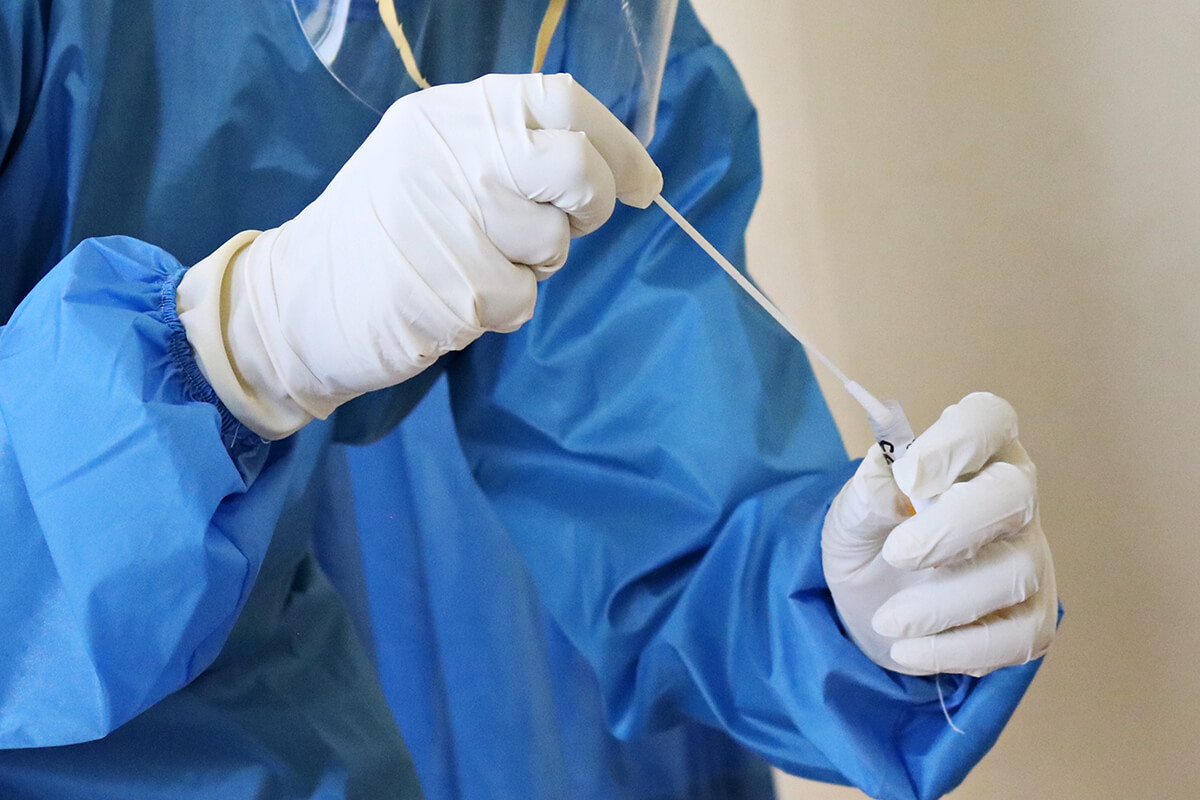Covid-Proofing Workplaces and Gatherings: Why SARS-CoV-2 Testing is More Effective than Proof of Vaccination

The RNA virus SARS-CoV-2 (responsible for the illness COVID-19) continues to mutate and infect its hosts, despite vaccination. To understand why, we need to take a look at some basic mechanisms of virology.
RNA viruses are highly mutable
RNA viruses are highly mutable, acquiring approximately 1 mutation each replication, depending on the specific species and strain. In contrast, many DNA viruses have comparably robust proofreading mechanisms, mutating significantly less frequently than RNA viruses. https://www.ncbi.nlm.nih.gov/pmc/articles/PMC2937809/
Coronaviruses do have a proofreading mechanism, but it is less efficient than the proofreading mechanism of many DNA viruses. With the ability to correct some mutations, coronaviruses may mutate slower than other RNA viruses. However, coronaviruses possess the largest genomes among RNA viruses, so their size might allow for accumulation of mutations. Studies have yet to confirm the mutation rate of SARS-CoV-2, but it is likely similar to that of SARS-CoV and other coronaviruses.
The high mutability of RNA viruses is one reason that the current coronavirus vaccines do not inhibit SARS-CoV-2 transmission as effectively as the smallpox vaccine has inhibited smallpox, a DNA virus. But even among different RNA viruses such as SARS-CoV-2 and poliovirus, the mutational cost of viral success also varies.
RNA viruses SARS-CoV-2 and poliovirus have different levels of mutational success
As compared to SARS-CoV-2, why is poliovirus so highly inhibited by its vaccines, without the production of multiple different successful escape mutants?
In 2020, many doctors had postulated that a vaccine could effectively halt community transmission of SARS-CoV-2, similar to what we have seen with the highly effective poliovirus vaccine. However, SARS-CoV-2 and its current vaccines can not be compared to poliovirus and its vaccines, with respect to creating herd immunity to protect the vulnerable immunocompromised population. This is because the “mutational fitness” of poliovirus is significantly lower than the mutational fitness of many respiratory viruses such as coronaviruses and rhinoviruses.
Why are there differences in mutational fitness between poliovirus and respiratory viruses such as SARS-CoV-2?
The infectivity of poliovirus is more highly constrained by mutations than the infectivity of SARS-CoV-2
The poliovirus vaccine is highly effective at inhibiting productive infections of poliovirus, largely because even though it is a highly mutable RNA virus, its infectivity is highly constrained by mutations. This is in stark contrast to coronaviruses and rhinoviruses. These highly mutable viruses are not as highly constrained by mutations. This lower mutational constraint results in the rapid and successful generation of multiple coronavirus and rhinovirus variants that are infectious, and can reinfect people, including those who have been vaccinated against the original strain but not infected.
The mutational fitness of many respiratory RNA viruses (such as coronaviruses and rhinoviruses) is a contributor to why there has never been a human vaccine to the “common cold”. In fact, there are approved animal coronavirus vaccines that were developed many years ago, but many veterinarians today no longer give these to our pets, because their efficacy is low. With low efficacy, a vaccine risk can be considered higher than its benefit.
In other words, the fitness “cost of mutation” is higher in poliovirus than it is in many rhinoviruses and coronaviruses, where poliovirus is under more stringent evolutionary constraints. The outcome is that far more successful escape variants will be generated by rhinoviruses and coronaviruses, rendering a potential rhinovirus or coronavirus vaccine less effective than the vaccines to viruses (such as poliovirus) that have more stringent evolutionary constraints.
What is the mechanism underlying the significantly different costs of mutations between poliovirus and respiratory viruses such as SARS-CoV-2?
Differences in mutational fitness may depend upon the different receptors for SARS-CoV-2 and poliovirus
The significant difference in mutational fitness of SARS-CoV-2 versus poliovirus may be due in part to expression of different viral receptors in different tissues of the body. There is a greater expression of SARS-CoV-2 receptors in the respiratory system, whereas there is a greater expression of poliovirus receptors in the small intestine.
Possibly, most poliovirus mutations may disable the ability of the virus to survive the harsh environment of the gut. Additionally, the very short time between exposure to SARS-CoV-2 and binding of the virus to its respiratory receptors may allow less time for an immune response to kick in, as compared to poliovirus which travels through the gastrointestinal tract to reach its major receptors.
The endemic nature of respiratory viruses
Similar to influenzas, enteroviruses, rhinoviruses, and other coronaviruses, we can expect SARS-CoV-2 cases to be endemic in the population. As with any highly pathogenic microbe for which there is no hard stop, we must remain vigilant in our protection of populations such as the elderly and comorbid that are at high risk of severe disease and death.
With SARS-CoV-2, as with most other pathogens, the most important factor regarding how likely an individual is at harboring high viral loads and transmitting disease, is not solely whether or not the person is vaccinated, but what is the overall health picture of that individual. This can include many factors including age, activity level, immune status including comorbidities, and vaccination or infection status. For example, an unvaccinated 30-year-old healthy, active person is significantly less likely to transmit SARS-CoV-2 than a vaccinated 70-year-old individual.
One way to think of SARS-CoV-2 susceptibility is this: We all have been effectively “immunized” to respiratory viruses such as rhinoviruses that cause the common cold, because we’ve all been infected by them. But we are all still likely to be infected by new rhinovirus variants, and this happens all the time. How likely we are to transmit these variants to others depends not on whether or not we’ve already been “immunized’ to rhinovirus, but instead, depends upon how healthy we are, thus how well our immune status limits viral replication and thus controls transmission.
Can vaccination be considered part of an individual’s overall health status? With most vaccines, the answer is yes. But with the current SARS-CoV-2 vaccines, that answer really is not as straightforward. For example, take a look at Omicron.
Omicron
Omicron has about 46 mutations, 23 of which are in the spike protein. 3D structural studies show that the omicron spike mutations disable efficient binding of the virus with the vaccine-induced antibodies, but the mutations do not significantly inhibit viral binding to the human receptor. https://www.ncbi.nlm.nih.gov/pmc/articles/PMC8666303/
One research group has provided evidence that they believe the Omicron variant developed in a vaccinated individual. When the vaccinated person was infected with SARS-CoV-2, the vaccine-induced immunity recognized and inhibited the nominal virus as well as similar variants. However, the new variant that outcompeted the other variants was the one that was able to bind to cellular receptors while partially evading immunity. This variant successfully replicated and was transmitted among the population as omicron. Although we may never know the who/when/how of Omicron patient zero, the researchers present a plausible theory. https://doi.org/10.1002/jmv.27530
SARS-CoV-2 testing is more effective than proof of vaccination when screening people for infection
Because SARS-CoV-2 variants can infect and replicate to transmissible levels in both unvaccinated and vaccinated individuals, proof of vaccination can not detect whether someone is infected with and able to transmit a SARS-CoV-2 variant. However, a good quality SARS-CoV-2 test can provide a better indication that a person is harboring the virus.
Tests available to the public include the antigen test and the nucleic acid amplification test (NAAT). An antigen test is rapid, and can detect a symptomatic infection. A nucleic acid amplification test (NAAT) such as PCR or LAMP can detect asymptomatic and symptomatic infections. A test that can detect more than one different viral targets can be the most effective at detecting the widest variety of SARS-CoV-2 variants, thus the most effective at screening populations for infection.
